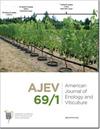评估美国葡萄行业对杀菌剂抗性缓解措施的理解
IF 1.8
3区 农林科学
Q3 BIOTECHNOLOGY & APPLIED MICROBIOLOGY
引用次数: 6
摘要
2019年,对来自20个州的252名美国葡萄行业成员进行了一项全国性调查,评估了他们对杀菌剂抗性管理的认识、这些知识在葡萄园实践中的应用以及知识获取来源。总体而言,受访者表现出对阻力管理实践的清晰理解。具体分布受被调查者的工作角色、行业经验持续时间和农场经营规模的影响。在全国范围内,受访者对FRAC(杀菌剂耐药性行动委员会)的首字母缩略词比较熟悉,近75%的受访者表示他们可以识别杀菌剂的FRAC代码。他们觉得自己有一定的能力,他们可以设计一个符合抗药性管理原则的杀菌剂项目。受访者认为,在全国范围内,杀菌剂耐药性是一个严重的问题,而在他们自己的葡萄园,这是一个温和的问题。他们对包括轮换使用不同FRAC代码的杀菌剂、避免多次连续使用相同的商品名称或FRAC代码、与不同FRAC代码混合的水箱、在喷洒程序中使用多站点产品、常规喷雾器维护和校准以及良好的树冠管理等做法进行了排名,这些做法对管理杀菌剂抗性非常到极其重要;然而,诸如在商品名称之间轮换和坦克混合不同商品名称的做法则略显重要。受访者认为,以大学为基础的推广项目是杀菌剂功效和杀菌剂管理(抗性管理)的主要信息资源。为了最大限度地发挥潜在的效果,这些结果表明,未来的教育工作应着眼于改进杀菌剂耐药性管理的实践,并应与目标受众的知识基础和人口因素保持一致,特别是他们的工作角色、经验和操作规模。本文章由计算机程序翻译,如有差异,请以英文原文为准。
Assessing the United States Grape Industry’s Understanding of Fungicide Resistance Mitigation Practices
In 2019, a national survey of 252 members of the United States grape industry from 20 states assessed knowledge perception of fungicide resistance management, application of that knowledge to vineyard practices, and knowledge acquisition sources. Overall, respondents demonstrated clear understanding of resistance management practices. The specific distribution of responses was influenced by the respondent’s job role, duration of industry experience, and their farming operation size. Nationally, respondents were moderately familiar with the acronym FRAC (Fungicide Resistance Action Committee), with nearly 75% indicating they could identify the FRAC code of a fungicide. They felt moderately competent they could design a fungicide program that adhered to resistance management principles. Respondents identified fungicide resistance as a serious problem nationally, and as a moderate problem in their own vineyards. They ranked practices that include rotating fungicides of different FRAC codes, avoiding multiple sequential applications of the same trade name or FRAC code, tank mixing with different FRAC codes, using multisite products in a spray program, routine sprayer maintenance and calibration, and good canopy management as very-to-extremely important in managing fungicide resistance; whereas practices such as rotating between trade names and tank mixing different trade names ranked slightly important. Respondents identified university-based extension programs as the primary information resource for fungicide efficacy and fungicide stewardship (resistance management). To maximize potential effect, these results suggest that future educational efforts should be aimed at improving practices for fungicide resistance stewardship and should align with the knowledge-base and demographic factors of the target audience—particularly their job role, experience, and size of operation.
求助全文
通过发布文献求助,成功后即可免费获取论文全文。
去求助
来源期刊

American Journal of Enology and Viticulture
农林科学-生物工程与应用微生物
CiteScore
3.80
自引率
10.50%
发文量
27
审稿时长
12-24 weeks
期刊介绍:
The American Journal of Enology and Viticulture (AJEV), published quarterly, is an official journal of the American Society for Enology and Viticulture (ASEV) and is the premier journal in the English language dedicated to scientific research on winemaking and grapegrowing. AJEV publishes full-length research papers, literature reviews, research notes, and technical briefs on various aspects of enology and viticulture, including wine chemistry, sensory science, process engineering, wine quality assessments, microbiology, methods development, plant pathogenesis, diseases and pests of grape, rootstock and clonal evaluation, effect of field practices, and grape genetics and breeding. All papers are peer reviewed, and authorship of papers is not limited to members of ASEV. The science editor, along with the viticulture, enology, and associate editors, are drawn from academic and research institutions worldwide and guide the content of the Journal.
 求助内容:
求助内容: 应助结果提醒方式:
应助结果提醒方式:


